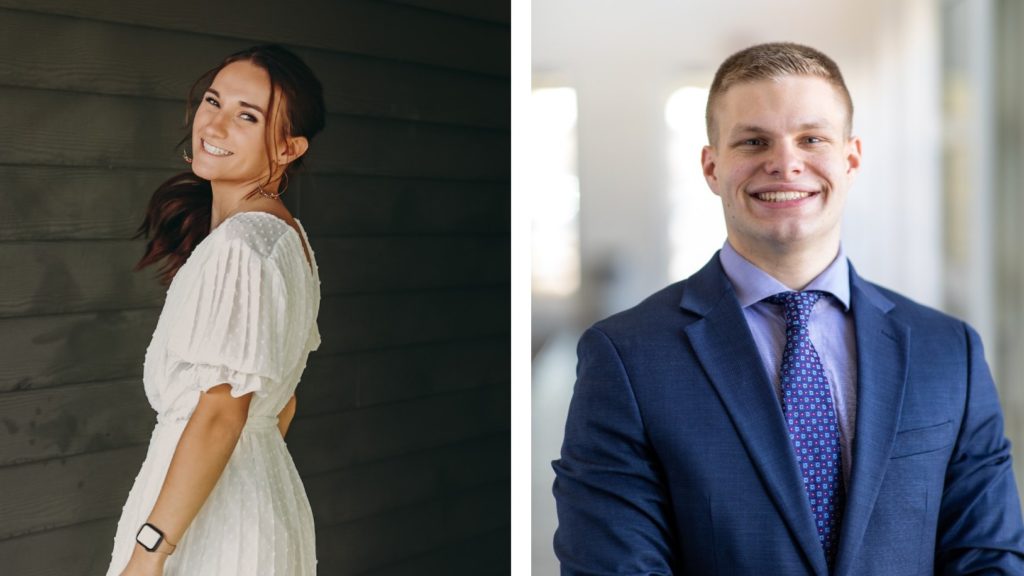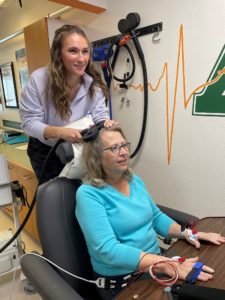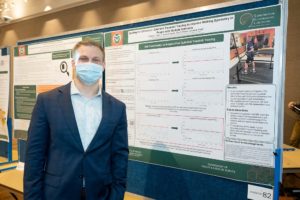
Jordan Acosta (’21) and Andrew Hagen are both first-year master’s students in the Department of Health and Exercise Science at Colorado State University. Both students have focused their graduate research on the experiences of people with multiple sclerosis – a neurodegenerative disease where nerve damage disrupts communication between one’s brain and body – and now are earning accolades and additional support for their research.
Acosta and Hagen were both chosen as Fellows by the Vice President for Research Office, a prestigious distinction designed to support excellence and interdisciplinary cooperation in graduate research. VPR Fellows are eligible for scholarship and travel support funding, as well as professional development, networking, and mentorship. The two students were selected following top reviews for their presentations in the VPR-sponsored 3 Minute Challenge. Acosta presented “The Ipsilateral Silent Period as a Neural Biomarker for Gait Asymmetries in Persons with Multiple Sclerosis,” and Hagen focused on “Splitting the Difference: Split-belt Treadmill Training Improves Walking Symmetry in People with Multiple Sclerosis.”
“We are incredibly proud of Jordan and Andrew, as well as the other VPR Fellows from our college,” said Lise Youngblade, dean of the College of Health and Human Sciences. “Students play such a key role in research, discovery, and sharing findings with the people who can directly benefit from their insights.”
Read on to learn more about their respective topics, journeys, and future endeavors.

Acosta’s research
Acosta is originally from Castle Rock, Colorado. She was drawn to CSU for the athletics, where she played softball during all four undergraduate years, as well as the challenging nature of CSU’s Honors Program and health and exercise science major.
After obtaining her undergraduate degree with a concentration in health promotion, the obvious next step for Acosta was to propel her research even further by pursuing a master’s degree. And what could be a more supportive environment than the department that she had thrived in for the past four years?
“I had built so many amazing friendships and established remarkable mentors within the program that choosing to apply for the graduate program seemed like the perfect choice,” said Acosta. “Specifically, I was interested in Dr. Brett Fling’s Sensorimotor Neuroimaging Laboratory where I could work with neurological disorders and understand neurophysiology deeper.”
Acosta’s current project, which she highlighted in her presentation, aims to expose the neural mechanism behind walking irregularities in people with multiple sclerosis. The degeneration of this mechanism causes over half of those diagnosed with multiple sclerosis to require mobility assistance within 18 years of their diagnosis.
“Our study will evaluate gait patterns and the communication between the two hemispheres of the brain to analyze what components of the nervous system may contribute to the mobility dysfunction evident in people with multiple sclerosis,” Acosta said.
Though this study focuses on those with multiple sclerosis, it has the potential to improve mobility for stroke survivors and people living with Parkinson’s disease and many other degenerative conditions.
Three-minute presentation
One of the most challenging aspects of the VPR Fellows presentation is that it is required to be three minutes or less. The topics these students grapple with are typically incredibly complex and weighed down with dense scientific jargon, requiring them to rethink their research in a way that’s digestible to the general public.

“Although the methods and details of the study are extremely important, I wanted to focus more on the why of the project and how impactful it could be,” said Acosta. “This challenging task was a great opportunity for me to present a very complex neurophysiological idea in an interactive and understandable manner. I am very grateful to my mentor, Dr. Fling, as well as my family and friends who also helped me navigate through many versions before my final draft.”
On being named a VPR Fellow
Becoming a VPR Fellow is a great honor. Of the 27 graduate students who presented their research in the 3 Minute Challenge this year, only 13 were chosen as VPR Fellows.
“The opportunities that come with being a VPR Fellow will allow me to grow in my leadership and other valuable skills that will benefit me in the future. I am proud of my hard work paying off and am extremely thankful for the constant support from my mentors, family, and friends,” Acosta said. “It feels incredible!”
What’s next for Acosta
Acosta is on a path that is heading toward a rewarding and fruitful career in neurology, and she plans to follow this path wherever it will take her.
“After graduate school, I plan on staying within the field of neurophysiology and neurological disorders,” said Acosta. “I have such a passion for working with clinical populations and understanding the sensorimotor components that underlie movement. Therefore, I’m excited to see where my path may take me in the future.”
Hagen’s research
Hailing from Minnesota, Hagen’s academic journey began at Bethel University in St. Paul, where he earned his undergraduate degree in biokinetics. From there, he was guided by his mentors into the field of neuroscience, where his interest in neurodegenerative impairments was piqued.

His first hands-on experience in this field was as an intern at the Cleveland Clinic, researching in Jay Albert’s highly respected movement disorders lab. This opportunity allowed Hagen to get his foot in the door of neuroscience research and to discover his passion for learning, causing him to seek more opportunities like this one.
Subsequent experiences — first as an Innovation Research Scholar at the Mayo Clinic, then as a clinical biomechanics lab intern at the Training HAUS, working to support athletic performance with the NFL’s Minnesota Vikings, confirmed his interest in further study.
“As I was looking into graduate programs, I came upon Dr. Brett Fling’s lab at CSU and found his work to be super exciting and relevant to my interests,” Hagen said. “I sent him an email, hopped on a zoom call with him, and knew his lab was the place I wanted to be! So, I moved out here from Minnesota last summer and have been really enjoying my work here ever since!”
In the same vein as Acosta’s studies, Hagen is currently researching ways to improve walking symmetry for those with multiple sclerosis.
“We use a specific split-belt treadmill training routine, where the speed of each leg can be controlled independently, to adapt their walking patterns to be more symmetrical with each leg,” said Hagen.
Hagen also notes that multiple sclerosis is the youngest onset neurogenerative disease, as the average diagnosis happens between the ages of 20 and 40, which means that the majority of people with multiple sclerosis will be living with it for most of their lives. Improved walking symmetry would drastically reduce the risk of falls and injury, and would bring increased independence, mobility, and quality of life to those with multiple sclerosis.
Three-minute presentation
For Hagen, the biggest hurdle he had to overcome in this presentation was the time restriction.
“My first draft was over five-and-a-half minutes long, and I thought I was being brief!” said Hagen, “It was so difficult to pick out the important things and cut it down to three minutes, but I think this is a really important skill for scientists.”

With widespread access to scientific journals through the internet, there’s a need for the general public to be informed about the latest discoveries impacting health. It’s helpful for scientists to be able to translate their research to a more inclusive language that any person can grasp and – better still – apply to their own lives.
“Public understanding of what you are doing is really the bread and butter of being able to impact lives,” Hagen said.
On being named a VPR Fellow
Like Acosta, Hagen is thrilled to be welcomed into the group of high-achieving graduate students that make up the VPR Fellows of CSU.
“I’m really honored,” he said. “I try to take every opportunity I can to present my work. The VPR Fellows have historically had such a good group of people that have advanced to very successful futures! I’m really excited to be a part of all the career and skill development opportunities.”
What’s next for Hagen
When asked what he plans to do in the future, Hagen sees many opportunities after earning his doctorate.
“I could see myself in many areas such as continuing in academia and becoming a professor or being a scientist for a company. The options after I finish my Ph.D. are endless, but I know I want to keep working in populations with neurodegenerative impairments as I continue my career.”
Additional VPR Fellows in the College
“The VPR Fellows program fosters emerging scientists who are just beginning to make a difference in our world through their passions and knowledge-sharing,” said Youngblade. “We are proud to have so many of our graduate students recognized by this program, and eager to celebrate future successes with them as their careers progress.” Learn more about the other VPR Fellows from the Department of Food Science and Human Nutrition and the School of Social Work.
The Department of Health and Exercise Science is a part of CSU’s College of Health and Human Sciences.